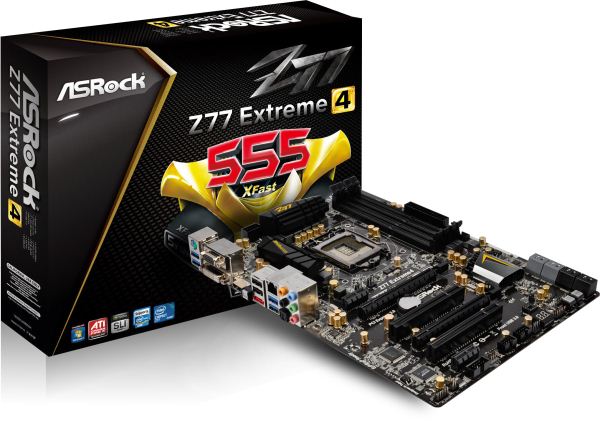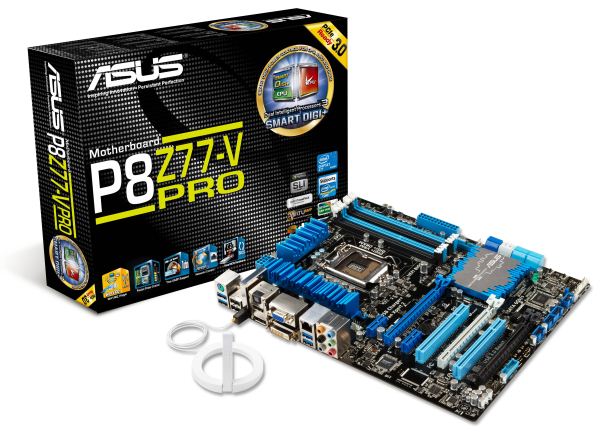Intel Z77 Motherboard Review with Ivy Bridge - ASRock, ASUS, Gigabyte, and MSI
by Ian Cutress on May 7, 2012 7:40 PM EST- Posted in
- Motherboards
- MSI
- Gigabyte
- ASRock
- Asus
- Ivy Bridge
- Z77
Conclusion – ASRock Z77 Extreme4
I had high expectations of the ASRock product due to what we have seen in previous chipsets. Over time, they have developed this knack of offering a good performance product at a great price, and a large amount of free kit in the box to sweeten the deal.
The Z77 Extreme4 is the lower end enthusiast board coming out from ASRock at release (compared to a total 20 models listed on their website). Therefore, when it comes in at $135, we should like this price. In the box is not substantial, with just a pair of SATA cables and an SLI finger, but we are treated to the ASRock BIOS and Software package. The big addition on the package is the Internet Flash software, allowing users to update their BIOS to the latest without needing to download it in an Operating System.
Performance wise, ASRock seem to be lacking the enhanced Turbo option utilized by other motherboard manufacturers by default, so we may see it in future BIOS builds. The XFast LAN software also shows superior performance in incompressible transfers or real-world transfers compared to standard USB throughput.
By making this board a little bit smaller than ATX, this board is cheaper than the rest and I really like the styling. As long as you remember to adjust the default CPU fan speed, this inexpensive board would be a good choice for an Ivy Bridge build.
Conclusion – ASUS P8Z77-V Pro
Whenever a reviewer deals with a variety of products at different price points, thoughts go through the mind of a reviewer about where that additional money has gone. If you look at an ASUS board, the usual culprits pop up - vastly improved fan controls, superior BIOS and software, digital power delivery, and a general feel that the board is solidly built. ASUS has gone another step further with their Z77 range, and on the Pro this means an Intel NIC as standard, onboard WiFi, USB Flashback, all four Ivy Bridge video outputs available, USB 3.0 Boost, Q-LED for POST diagnosis, and even a Thunderbolt header which connects to a future ASUS Thuderbolt add-in card (sold separately).
Performance on the P8Z77-V Pro is bolstered by the MultiCore Enhancement BIOS setting, which invokes maximum turbo mode for any core loading by default giving multi-threaded results an advantageous score. I feel this sort of setting will quickly become the standard, as motherboard manufacturers try to provide the best bang for buck on their products.
Despite the mishap regarding my CPU cooler (which is of an old design), there is not much I can complain about on the P8Z77-V Pro. It overclocked a set of G.Skill DDR3-2666 memory to DDR3-2950 with a little increase in voltage without issue, and it overclocked the CPU rather vigorously to give 4774 MHz, even if it was a little toasty under load.
At $225/$235, the motherboard spectrum for Ivy Bridge will separate the very cheap and the very functional. For a long-term build, the ASUS P8Z77-V Pro is a solid choice, and even has ASUS Premium Service warranty if you are in North America.
Update: I have just been informed that the Pro will soon drop in MSRP to $209. This makes it even more affordable.












117 Comments
View All Comments
drbuzbee - Thursday, May 10, 2012 - link
The Lan read and write sequential speeds are labeled MBytes ps but undoubtedly are reported in Mbits ps.millisec - Thursday, May 10, 2012 - link
The Gigabyte UD3 is a nice board but it's a little annoying that's the board GB keeps sending out for reviews because of the $160 price mark. For $29 more you get so much more in the UD5 with Realtek audio, dual lan with Intel/Atheros, PCI 3.0 X4 slot, more sata 3 ports and second Marvell raid controller. The extra $29 buys a lot vs. the UD3 and in IMO is a much better value. Just hoping the UD5 arriving today does not have the same problems with the G.Skill Ripjaws X 2400 kit Anand had. Won't be a happy camper...Zoomer - Tuesday, May 15, 2012 - link
$29 for extra sata ports = pass. ;)embeddedbill - Friday, May 11, 2012 - link
Hi Ian, any chance you will have an update on this board?embeddedbill - Friday, May 11, 2012 - link
What... Did that take about 3 minutes from this question to Anands article?smalM - Friday, May 11, 2012 - link
Black connectors, video ports, PS/2 - the first manufacturer who omits all that nonsense will get my money.KivBlue - Friday, May 11, 2012 - link
Gigabyte has gone cheap for sure, I have compared the specs for both on-board audio chips and Realtek clearly has more feature sets. Plus VIA interface looks hideous. My current system's motherboard is Gigabyte and while they have improved things with UEFI, the feature set they have in it is pretty much the same as the old BIOS, ASUS clearly has a more comprehensive UEFI in that regard, I would go with ASUS motherboard in the future as I'm no longer a novice and someone who wants to take full control of a system.bobster1 - Sunday, May 13, 2012 - link
I've been debugging crashes at stock and overclock for a few days and finally seem to have found the cause, and thought it was worth mentioning here as I didn't see anything about it in the article.I was finding my 7970 crossfire/UD3h/3770k setup was locking up frequently in games like the Witcher 2 - the system would freeze and had to be turned off and on again. I discovered by accident that the games became stable if I had prime95 running in the background, and eventually concluded that it must have something to do with the voltages at lighter loads. When I bumped up the voltage to 1.25v in the BIOS (using the static setting, rather than dynamic voltage), it seems to have solved the problem. I'm guessing this is due to Ivy Bridge taking responsibility for pci-e; it's rather unfortunate as it means I can't let the cpu use a lower voltage in an idle state without it rendering the system unstable when rendering 3d.
mikeyd55 - Tuesday, June 19, 2012 - link
Hi,First, thank you for addressing this important benchmark!
Your article notes that POST times can be improved by disabling non essential controllers.
It would be helpful to know, with the minimum controllers enabled to support a system built on either the PRO or DELUXE (Asus) boards, with: one NIC enabled in OS (only?), boot from one SSD and/or one optical drive connected to Z77 chipset ports (no third party storage controller needed), USB disabled on boot, but enabled in OS (if possible as with certain Intel boards?), and any Wireless option disabled, what could be expected.
Conditioned - Wednesday, June 20, 2012 - link
So how was dpc measured? If you disable intel-c state and all other powersaving features it makes an absolutely huge difference in dpc.